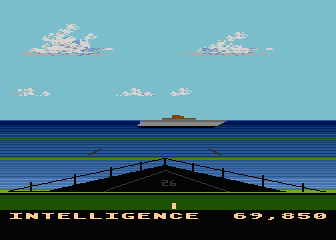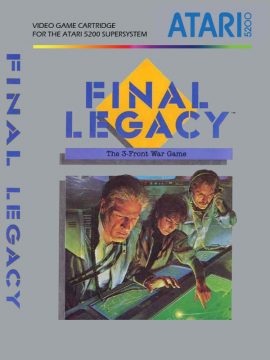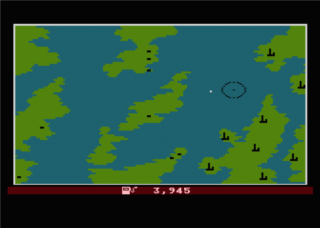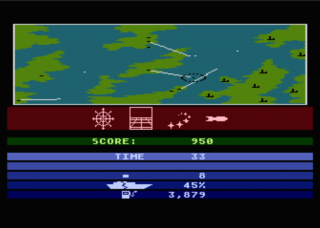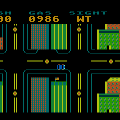Old video games introduced many of the basic concepts and genres that are still used today, which were refined over time. Platformer shooters still exist for example – see Cuphead. Beat-em-ups still exist as well, such as Super Crush K.O. or even The Wonderful 101, both of which put original twists on that genre’s style of gameplay. There are also the games which are credited with birthing or popularizing a genre, such as Wizardry or Ultima, among the earliest dungeon crawlers and RPGs in existence.
To a modern gamer, playing the oldest examples of such genres might be like watching the movie Halloween or TV show Seinfeld – the ideas that they pioneered have since been copied and refined many times over, so much so that the progenitors look bland by comparison.
But some old games tried ideas that were not only original, but not truly copied since. Final Legacy, developed by Atari themselves, is a game that innovated for its time, and is based around a concept that could well be considered original by modern standards. It lacks the polish of modern games, but its originality makes it stick out both for the time and even now.
Final Legacy is difficult to fit into a single genre, as it contains elements of strategy, combat of multiple types, and minigames. In fact, it was designed by Atari’s newly created Advanced Games Group, a division created in the hopes of revitalizing a company that was bleeding money at the time.
The idea behind the game is that there is a war going on, and you must defend multiple cities from an enemy army that is planning to destroy them all with long distance missiles. To fight them off, you have only a single battleship* known as the Legacy, that traverses the map, engaging in combat across sea, land and air. Combat in all three of these areas is handled in the form of what are essentially minigames. Players can summon a menu at any time on the map to change modes, switching to the other combat modes or back to navigation.
*or submarine – the developers, Dan Oliver and Steve Englehart – yes, the Marvel comics writer – had disagreements on whether the player should control a ship or a submarine
Sounds simple enough, but what makes this game more unique than other video games that attach multiple minigames to a larger concept, is that multiple things are happening in real time, and the player must juggle all of them, especially on higher difficulty levels. There is a metagame, and the minigames are a continuous part of it.
But first, a brief rundown of each minigame:
The “torpedo” minigame involves ship-to-ship combat. Or submarine-to-ship, if Dan Oliver had his way.*
*not only is it unusual for a ship rather than a submarine to fire torpedoes, but Steve Englehart had said that he tried to make it a little ambiguous so Dan would be happy, and designed the bow of the ship to hopefully look similar to what he thought the bow of a submarine might look like
Players fight off a ship which is firing missiles at them, while birds fly in the sky flapping their wings, blissfully unaware of the war raging down below. The game uses multiple visual effects to try to achieve a pseudo-3D look: parallax scrolling (parts of the background move by at different speeds), numerous different sprites to represent the enemy ship at different distances, and layered “lines” of moving water.
In a silly example of ancient video game logic, you can avoid the missile attacks by turning the camera so the missile goes off the screen. Simply look away from the missile to dodge the attack, and then look back and chase after the ship and shoot it to blow it up. Ramming into the enemy ship works too, but the player will also take damage.
Three different types of ships show up, one of which is the Intelligence ship. If that’s destroyed, additional secret missile silos appear on the map. More on that later.
There are significant technical limitations on display. Only one ship shows up at a time. Only one shot fired by either ship can exist at a time until the previous shot has either hit or missed. If the player engages in battle with multiple ships within range, then the ships merely show up one after another as each previous one is destroyed.
When players are within range of missile silos on the ground, they can engage in sea-to-land combat.
Here, on a simple grid performing a surprisingly well-done 3D effect, players seek out and shoot moving symbols that represent the different missile launchers, and try to destroy them before time runs out. If there’s more than one missile silo in that location, then the second one simply appears after the first is destroyed.
Why is there a time limit? Because the enemy, fully aware that their missiles are about to be destroyed, launches them immediately. When time runs out, the missiles will strike one of the cities you need to protect. While it’s possible to back out of attacking the missile silo and instead destroy the missiles, the next attack on the missile silo could provoke another attack anyway. So it might be best to destroy the missile launchers as quickly as possible, then immediately switch to sea-to-air mode for the next minigame:
Sea-to-air combat is also very simple. Shoot down missiles as they fly through the sky. Missiles that pass by can strike the cities if the timer is low; otherwise, the game will say “refocussing” (sic) and “zoom out” to restart the missile fight. On the screen, the name of the city under current attack is shown along with its life percentage. If multiple cities are under attack, then destroying one set of missiles will lead into fighting the next, and so on until all are destroyed.
If a secret missile silo that hasn’t yet been revealed on the map fires a missile, then the player will have to destroy the missiles out of the air but will still be unable to attack the silo until it’s revealed. On any difficulty level higher than the lowest, some number of missile silos will be hidden (that is, invisible on the map and unattackable) and can only be revealed by destroying Intelligence ships, which themselves are indistinguishable from other kinds of ships until they’re attacked. Furthermore, ramming the Intelligence ships doesn’t reveal the missile silos; the ships specifically must be shot down.
What makes Final Legacy distinct is that all of these minigames are connected to the main metagame, and to each other as well. The missile attacks and enemy ship movements are all occurring in real time. The player can take damage from ship attacks while moving around the map, and missiles can be fired while engaging in ship combat. If an enemy ship gets dangerously close while the player is engaged in sea-to-land or sea-to-air combat, the player can be attacked by the ship while they’re busy shooting missiles out of the sky.
On lower difficulty levels, the game is fairly simple. Features such as hunting down Intelligence ships to reveal hidden missile silos, or missile silos frequently firing missiles on their own, don’t really come into play. But higher difficulty levels force players to juggle all of these elements at once, changing Final Legacy into more than a loose collection of minigames but instead a strategic, fast-paced metagame with a lot going on that needs to be managed by a skilled player. The fact that it’s possible to back out of combat at any time by pressing the space bar and switch to a different mode becomes more useful when missile launches and surprise ship attacks can happen at any time. Players might have to sacrifice a little bit of their cities’ life in order to protect their own.
The presentation is basic and mostly standard for the time. There’s a theme song during the title screen and victory, and like most music of the era, it’s not entirely original music but instead variations on familiar themes – a snippet of the 1978 Superman movie theme, followed by a snippet of the 1979 Star Trek: The Motion Picture theme, before it goes off into its own thing. Video game music and sound effects in the early 1980s were typically made by programmers who had no composition skill, so they played it safe and kept things simple and familiar, which explains why well-known existing songs appeared in so many of the earliest video games.
One original visual effect the game uses is having the map “fold up” when the player brings up the menu to attack enemies.
No music plays during gameplay, using only sound effects to set the mood. There are a few basic sounds for shots being fired, and a distinct warning whenever the missiles are launched, but other than that, silence.
Interestingly, there’s also an accessibility feature in the form of a left-handed mode. Selecting this rotates the controls 90 degrees so the player can hold the controller with the button on the right side instead of the left. This was decades before accessibility features would become more common and talked about!
Final Legacy may have been part of a series of “advanced” games meant to save a struggling Atari, but the game instead became very obscure. The development was also a bit rushed – it was planned to have six combat gameplay modes instead of three, and Atari being sold off to new owners also interrupted plans and resulted in the dissolution of the Advanced Games Group.
Another thing to note is that there exist multiple versions of the Atari 8-bit computer version of Final Legacy. The game was intended to be sold in two forms – an American-oriented version with text to describe everything, and a version intended for the international market that uses less and simpler text (e.g. “time” instead of “time to impact”, and using a star rating for enemy ships instead of actually naming them by type), and focuses more on the use of visual icons, such as a gas can or a picture of a damaged ship instead of the words “fuel” or “damage.” The screenshots in this article are a combination of pictures taken from a late beta US release and the final international release.
The following set of pictures shows just how different the onscreen indicators look between versions:
The above comparison doesn’t show the fuel listed in the US version, because the US version’s picture is taken from a nonfinal version that hadn’t yet added that mechanic. (While many betas and development builds of this game can be found, final releases are very difficult to get ahold of.) But otherwise, the visual differences are clear.
Final Legacy was developed for both the Atari 5200 console and Atari 800 computer, but the 5200 version went unreleased, while the 800 computer version was released in 1984, a year after the great video game crash.
There was also a port done by Paradox to the Atari ST computer in 1988. This version has a few differences, such as endlessly playing a shortened version of the game’s already short theme song throughout all of gameplay, having an awful framerate during the ship-to-ship combat segments, while missing details like the birds in the sky. However, it also added some sound effects and visual details. For instance, during sea-to-air combat, instead of taking place in a black void, the missiles are being shot out of the sky over a mountain range.
Final Legacy never caught on. It was the victim of circumstance, due to its poor release timing. Perhaps if it had been released before the great video game crash of 1983, it could have received attention for its original gameplay and been considered a classic. As it is, it was the end of one era of the once mighty Atari, a company that once gave the world such original ideas as Missile Command and Crystal Castles, but would survive to go on to make games such as Gauntlet and Primal Rage. Final Legacy was neither final nor a legacy, but instead merely an interesting footnote, and a very original game whose concept has never been copied since.

